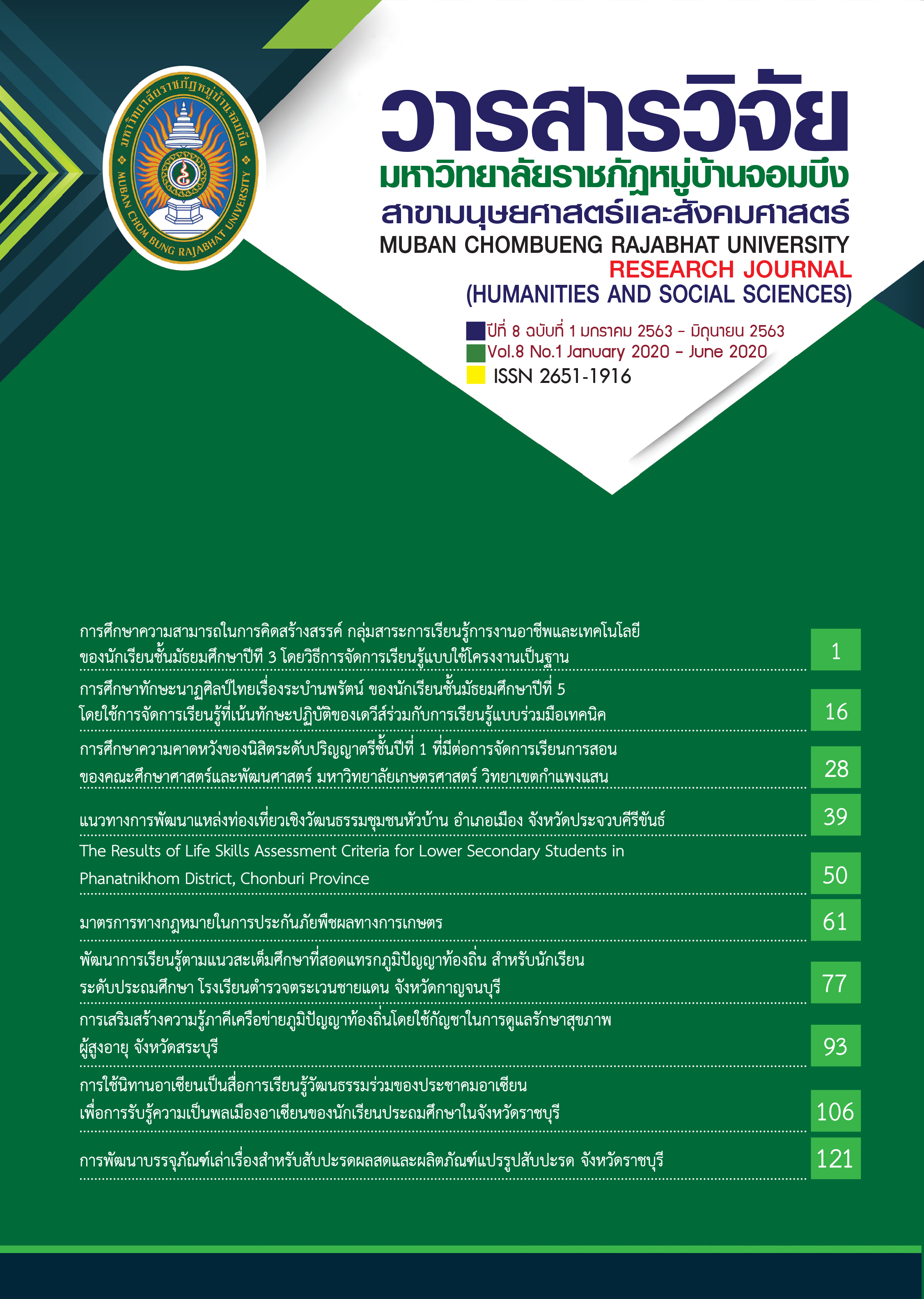การศึกษาความสามารถในการคิดสร้างสรรค์ กลุ่มสาระการเรียนรู้การงานอาชีพและเทคโนโลยี ของนักเรียนชั้นมัธยมศึกษาปีที่ 3 โดยวิธีการจัดการเรียนรู้แบบใช้โครงงานเป็นฐาน
คำสำคัญ:
วิธีการจัดการเรียนรู้แบบใช้โครงงานเป็นฐาน, ความสามารถในการคิดสร้างสรรค์, แผนการจัดการเรียนรู้แบบใช้โครงงานเป็นฐาน, กลุ่มสาระการเรียนรู้การงานอาชีพและเทคโนโลยีบทคัดย่อ
การวิจัยครั้งนี้ มีวัตถุประสงค์เพื่อ 1) พัฒนาและประเมินแผนการจัดการเรียนรู้ โดยใช้โครงงานเป็นฐาน รายวิชาการงานอาชีพและเทคโนโลยี ของนักเรียนชั้นมัธยมศึกษาปีที่ 3 กลุ่มสาระการเรียนรู้การงานอาชีพและเทคโนโลยี เทียบกับเกณฑ์ และ 2) ศึกษาความสามารถในการคิดสร้างสรรค์ของนักเรียนชั้นมัธยมศึกษาปีที่ 3 หลังได้รับการจัดการเรียนรู้แบบใช้โครงงานเป็นฐาน การวิจัยครั้งนี้เป็นการวิจัยแบบก่อนทดลอง กลุ่มตัวอย่างที่ใช้ในการวิจัย เป็นนักเรียนชั้นมัธยมศึกษาปีที่ 3 จำนวน 30 คน ที่เรียนในกลุ่มสาระการเรียนรู้การงานอาชีพและเทคโนโลยี ภาคเรียนที่ 2 ปีการศึกษา 2561 วิทยาลัยนาฏศิลปอ่างทอง จังหวัดอ่างทอง ได้มาโดยวิธีการสุ่มแบบหลายขั้นตอน เครื่องมือที่ใช้ในการวิจัย คือ (1) แผนการจัดการเรียนรู้ รายวิชาการงานอาชีพและเทคโนโลยี แบบใช้โครงงานเป็นฐาน จำนวน 8 แผน ใช้เวลารวม 22 ชั่วโมง (2) แบบประเมินโครงงานเพื่อวัดความคิดสร้างสรรค์ โดยมีการวัดประเมิน 4 ด้าน ประกอบด้วย (1) ด้านความคิดคล่องแคล่ว (2) ด้านความคิดยืดหยุ่น (3) ด้านความคิดริเริ่ม และ (4) ด้านความคิดละเอียดลออ มีค่าความเหมาะสมและค่าดัชนีความสอดคล้องเท่ากับ 0.80 สถิติที่ใช้ในการวิเคราะห์ข้อมูล ได้แก่ ค่าเฉลี่ย และส่วนเบี่ยงเบนมาตรฐาน
ผลการวิจัย พบว่า 1) ผลการประเมินแผนการจัดการเรียนรู้ โดยใช้โครงงานเป็นฐาน รายวิชาการงานอาชีพและเทคโนโลยี ของนักเรียนชั้นมัธยมศึกษาปีที่ 3 ในภาพรวมมีความเหมาะสมและสอดคล้องกันทุกองค์ประกอบ อยู่ในระดับมาก ( = 4.58, S.D = 0.62) 2) ความสามารถในการคิดสร้างสรรค์ ของนักเรียนชั้นมัธยมศึกษาปีที่ 3 หลังได้รับวิธีการจัดการเรียนรู้แบบใช้โครงงานเป็นฐานอยู่ในระดับดีมาก
เอกสารอ้างอิง
กระทรวงศึกษาธิการ. (2561). หลักสูตรแกนกลางการศึกษาขั้นพื้นฐานพุทธศักราช 2551 (ฉบับ
ปรับปรุง พ.ศ. 2560). กรุงเทพฯ: ชุมชนสหกรณ์การเกษตรแห่งประเทศไทยจำกัด.
ชโลธร ใจหาญ. (2558). การใช้การเรียนรู้แบบโครงงานเพื่อพัฒนาความคิดสร้างสรรค์ของนักเรียนชั้นประถมศึกษาปีที่ 4 โรงเรียนเทศบาลรัตนบุรี. วิทยานิพนธ์ศึกษาศาสตรมหาบัณฑิต, มหาวิทยาลัยธุรกิจบัณฑิตย์.
ชาตรี บัวคลี่. (2557). การประยุกต์ใช้แนวคิดของ Dr. Edward de Bono เพื่อการออกแบบสิ่งพิมพ์ที่สนใจ. วารสาร Veridian E-Journal. 7(1), 773.
ทวีป อภิสิทธิ์. (2559). กิจกรรมส่งเสริมความคิดสร้างสรรค์สำหรับเด็กและเยาวชน. กรุงเทพฯ: โรงพิมพ์แห่งจุฬาลงกรณ์มหาวิทยาลัย.
ประพันธ์ศิริ สุเสารัจ. (2556). การพัฒนาการคิด (พิมพ์ครั้งที่ 5). กรุงเทพฯ: ห้างหุ้นส่วนจำกัด 9119 เทคนิคพริ้นติ้ง.
ปรีดี ปลื้มสำราญกิจ. (2560). ปัจจัยที่มีผลต่อทักษะในศตวรรษที่ 21 ของผู้เรียน. วไลยอลงกรณ์ปริทัศน์. 7(3), 141-158
พิมพันธ์ เดชะคุปต์, พเยาว์ ยินดีสุข, และราเชน มีศรี. (2556). การสอนคิดด้วยโครงงาน: การเรียนการสอนแบบบูรณาการทักษะในศตวรรษที่ 21. กรุงเทพฯ: โรงพิมพ์แห่งจุฬาลงกรณ์มหาวิทยาลัย.
วิจารณ์ พานิช. (2555). วิถีสร้างการเรียนรู้เพื่อศิษย์ในศตวรรษที่ 21. กรุงเทพฯ: มูลนิธิสดศรีสฤษดิ์วงศ์.
สำนักงานเลขาธิการสภาการศึกษา. (2560). แผนการศึกษาแห่งชาติ พ.ศ. 2560-2579. กรุงเทพฯ: พริกหวานกราฟฟิค.
สุคนธ์ สินธพานนท์. (2558). การจัดการเรียนรู้ของครูยุคใหม่เพื่อพัฒนาทักษะผู้เรียน. กรุงเทพฯ: ห้างหุ้นส่วนจำกัด 9119 เทคนิคพริ้นติ้ง.
Dewey, J. (1897). My pedagogic creed. The School Journal. LIV (3) Retrieved from http://www.infed.org/archives/e-texts/e-dew-pc.htm
Efstratia, D. (2014). Experiential education through projectbasedlearning. Procedia- SocialandBehavioralSciences,152,1256-1260.
Guilford, J.P. (1967). The Nature of Human Intelligence. New York: McGraw - Hill.
ดาวน์โหลด
เผยแพร่แล้ว
รูปแบบการอ้างอิง
ฉบับ
ประเภทบทความ
สัญญาอนุญาต
วารสาร TCI อยู่ภายใต้การอนุญาต Creative Commons Attribution-NonCommercial-NoDerivatives 4.0 International (CC BY-NC-ND 4.0) เว้นแต่จะรุบุไว้เป็นอย่างอื่นโปรดอ่านหน้านโยบายของเราสำหรับข้อมูลเพิ่มเติมเกี่ยวกับการเช้าถึงแบบเปิด ลิขสิทธิ์ และการอนุญาต



